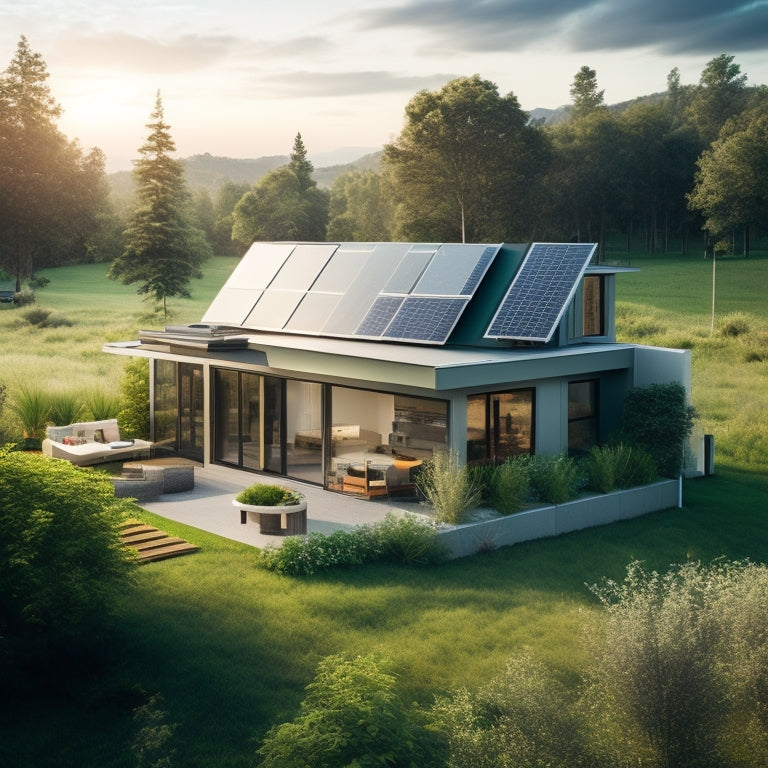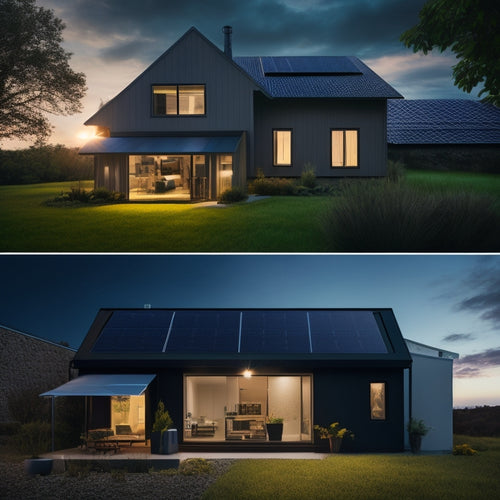
Design Your Dream Home Energy System Easily
Share
You're about to design your dream home energy system, and it starts with choosing the right software tools that can accurately assess your energy needs, calculate total wattage requirements, and handle complex calculations. You'll need to evaluate essential features like energy efficiency, system integration, backup power, and monitoring and control. From there, you'll design your solar panel array, factoring in orientation, tilt angle, and seasonal adjustments. You'll also need to size your battery storage needs based on energy consumption patterns, peak demand periods, and seasonal changes. As you maneuver through these vital decisions, you'll uncover a customized energy system that brings your dream home to life, and there's much more to investigate.
Key Takeaways
- Choose the right software tools to accurately calculate energy assessments and handle complex calculations for effective system design.
- Consider essential features like energy efficiency, system integration, backup power, monitoring, and scalability when selecting system components.
- Design your solar panel array with optimal orientation, tilt angle, and installation techniques to maximize energy generation and system performance.
- Size your battery storage needs based on energy consumption patterns, peak demand periods, and seasonal changes to ensure reliable backup power.
- Visualize your energy system's performance by analyzing consumption patterns and monitoring efficiency to make data-driven design decisions.
Choosing the Right Software Tools
How thoroughly have you considered the software tools you'll need to design your dream home energy system?
You'll want to evaluate various options to find the one that best fits your needs. Conduct thorough software comparisons to identify the tools that can help you create a detailed design.
When selecting software, consider the importance of accurate energy assessments and the ability to calculate total wattage requirements. Look for software that can handle complex calculations, such as energy consumption and system sizing.
Additionally, verify the software is compatible with your operating system and can integrate with other tools you may need.
Essential Features to Consider
When designing your dream home energy system, you'll need to contemplate a range of essential features to guarantee your system operates efficiently and effectively. These features will make certain your system integrates seamlessly with your home's energy needs, reducing energy waste and costs.
| Feature | Description |
|---|---|
| Energy Efficiency | Maximizes energy usage to minimize waste and reduce energy bills |
| System Integration | Guarantees seamless communication between system components for peak performance |
| Backup Power | Provides backup power during grid outages or peak energy usage |
| Monitoring and Control | Allows real-time monitoring and control of energy production and consumption |
| Scalability | Enables easy system expansion or upgrade as energy needs change |
Designing Your Solar Panel Array
Designing your solar panel array is a critical component of your dream home energy system, as it directly impacts the amount of renewable energy your system can generate.
When designing your array, you'll need to take into account solar panel orientation, which affects energy production. Ideally, your panels should face south (in the northern hemisphere) and be tilted at an angle between 30-40 degrees to maximize energy output, as this captures direct sunlight during peak hours optimal panel angle.
Additionally, seasonally adjusted sunlight angles due to Earth's axial tilt will also impact energy production.
You'll also need to choose suitable installation techniques, such as roof-mounted or ground-mounted systems, depending on your roof's condition and available space.
Properly designing your solar panel array guarantees you generate the most energy possible and optimizes your system's performance.
Sizing Your Battery Storage Needs
You've invested significant time and resources into generating renewable energy with your solar panel array, but without adequate battery storage, you risk wasting excess energy and leaving your home vulnerable to power outages.
To determine your battery storage needs, you'll need to calculate your energy consumption patterns. Analyze your daily energy usage to identify peak demand periods and overall consumption.
Regular monitoring of your battery's state of charge (SOC) and depth of discharge (DOD) battery monitoring and maintenance is essential to guarantee you're getting the most out of your battery. This will help you determine the required battery capacity to store excess energy generated by your solar panel array.
A general rule of thumb is to size your battery storage to cover 1-2 days of energy consumption. Consider factors like seasonal changes, appliance efficiency, and backup power requirements to guarantee your battery storage system can meet your energy needs during outages.
Visualizing Your Energy System
Your dream home energy system is taking shape, with a well-sized battery storage system in place to store excess energy generated by your solar panel array. Now, it's important to visualize how your system will perform under different scenarios. This involves analyzing your energy consumption patterns and system efficiency.
| Time of Day | Energy Consumption (kWh) | System Efficiency (%) |
|---|---|---|
| Morning (6am-9am) | 2.5 | 90 |
| Afternoon (12pm-3pm) | 1.8 | 95 |
| Evening (6pm-9pm) | 3.2 | 92 |
| Night (9pm-12am) | 1.2 | 98 |
Frequently Asked Questions
Can I Design a Home Energy System for a Rental Property?
You'll need to contemplate rental property considerations, such as landlord approval and lease terms, when designing a home energy system, as energy system limitations may impact its feasibility and effectiveness in a rental setting.
Are Energy-Efficient Appliances Required for a Dream Home System?
You don't necessarily need energy-efficient appliances for a dream home system, but incorporating them can maximize energy savings and reveal appliance benefits, such as reduced utility bills and a smaller carbon footprint.
How Do I Ensure System Compatibility With My Utility Company?
You'll want to review your utility company's regulations and make certain your system meets their grid connection requirements, obtaining necessary permits and approvals to secure a seamless integration with their infrastructure.
Will a Dream Home Energy System Increase My Property Value?
You'll likely see an increase in property value after installing a dream home energy system, as a property appraisal will reflect the added value of energy savings, potentially enhancing your home's worth by up to 10%.
Can I Install a Dream Home Energy System Myself?
You can attempt a DIY installation, but it's vital to understand the intricacies of energy system components, such as inverters, batteries, and panels, to guarantee a safe and efficient setup that meets local building codes and regulations.
Related Posts
-

Best Solar Powered Flashlights for Emergency Situations
When you're choosing the best solar-powered flashlights for emergency situations, focus on their brightness, battery ...
-

Advantages of Solar Generating Systems Over Traditional Energy
Solar generating systems provide several key advantages over traditional energy sources. You'll experience lower long...
-

Cost of Home Solar Battery
You're looking to invest in a home solar battery to reduce your grid reliance, but you're curious about the cost. The...


